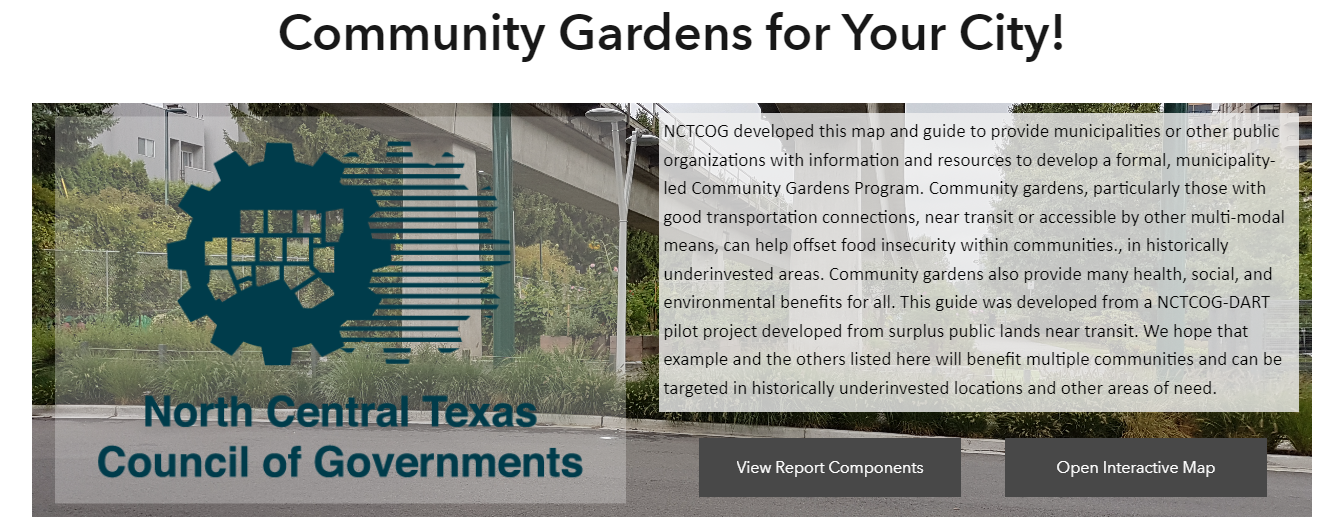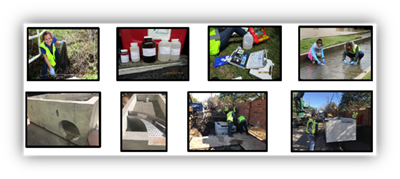Green Infrastructure
NCTCOG promotes the planning and construction of green or sustainable infrastructure in the region to help reduce carbon emissions, mitigate urban heat islands, reduce pollution from stormwater runoff, and provide health benefits to communities. Types of green infrastructure include LED and solar lighting, permeable pavement, “cool” pavement, bio-retention drainage areas, parks, community gardens, and shade trees.
Food Access, Community Gardens, and Transportation
NEW! The NCTCOG Community Gardens Public Program Guide was created to provide information, resources, and tools for city staff, decision-makers, and others to develop and implement a public community gardens program. The guide includes program frameworks and steps that municipalities and public agencies may consider when developing a publicly led community gardens program. The guide also contains an analysis of potential garden sites region-wide to act as a starting point for consideration of where community gardens should be located.
Appendix A - Program Resources
Appendix B - Example Agreements
Appendix C - Garden Start Up Resources
Appendix D - Other Resources
Click on the image below to learn more about this effort and to access an interactive map of the region-wide analysis of potential garden sites.
Blue-Green-Grey Funding Program
The Blue-Green-Grey funding program focuses on breaking the silos between water infrastructure, the environment, and transportation infrastructure to help create and fund innovative spaces that combine these components. The goal of the Blue-Green-Grey program is to support innovative pilot projects that provide resources for cities and organizations to use to replicate these ideas throughout the metroplex.
___________________________________________________________________________________________
Blue-Green-Grey 2021 Funding Opportunity
Round 3 of the Blue-Green-Grey Funding Program is closed for Application for New Ideas submittals. Eligible entities included cities, counties, non-profits, private firms, educational entities, and individuals.
A virtual pre-application meeting was held on July 15th for interested parties to learn about the proposal submittal and review process. For submittal requirements, please review the meeting information below.
Invitation to respond to Round 3 of the Blue-Green-Grey Application for New Ideas
Pre-Application Meeting Recording
Pre-Application Meeting Presentation
Pre-Application Meeting Q&A
Please contact Sydnee Mangini with questions.
__________________________________________________________________________________________
Blue-Green-Grey Environmental Panel
NCTCOG hosted a Blue-Green-Grey Environmental Panel on April 14, 2021 to gather feedback from stakeholders about the previously implemented funding program and awarded projects. This feedback will be presented to NCTCOG boards and used to develop a fourth call for projects in the coming months.
Panel Presentation - April 14, 2021
Summary
__________________________________________________________________________________________
Previously Funded Projects
Funding Year 2021
City of Allen Inlet Floatables Filter Project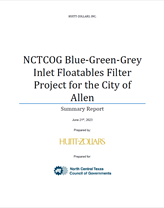
The purpose of this project was to design a non-proprietary Inlet Floatables Filter to improve stormwater quality and first flush debris entering the stormwater system and then discharged into creeks. The goal was to design a permanent filtration system, not impacting hydraulic capacity, to meet the Texas Commission on Environmental Quality's stormwater permitting requirements.
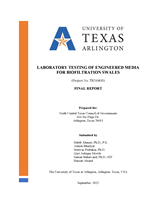
UTA Testing of Engineered Media for Biofiltration Swales
The purpose of this project was to investigate alternative methods to remove total suspended solids from run-off. In this project, a comprehensive laboratory investigation centered on using the expanded shale as a filter reduction in bioswales. While conventional filter media, including rocks, sand, and mulch, have been employed in bioswales to bolster infiltration capabilities, the potential of engineered expanded shale as an alternative medium remains relatively unexplored and under-documented.
Funding Year 2019
DART Hatcher Station Community Garden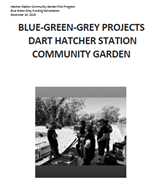
BGG funds were used for the development and implementation of a community garden located in an unused parcel in DART-owned right-of-way near Hatcher Station. The pilot project acted as a programmatic approach to create community gardens for areas designated as “food deserts”.
Bishop Arts Bicycle Parking Retrofitting Project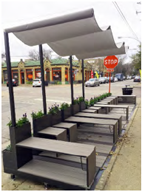
The Bicycle Parking Parklet Retrofitting Project took place in the Bishop Arts neighborhood in Dallas. Funds were used for the development and implementation of an eco-friendly bike parking and public seating parklet in the Bishop Arts District in Dallas. The pilot project established a replicable green parklet design, suitable for mixed use and neighborhood walkable retail districts.
City of Watauga Hightower Rain Garden Project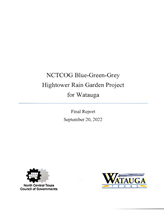
Summary: This project features the installation of a new rain garden on a storm drain inlet on Hightower Drive in Watauga. The intent of the project was to redirect storm water runoff to the rain garden to filter pollutants
prior to entry into the stormwater system. The project report includes a rain garden design that can be scaled to many areas.
Funding Year 2018
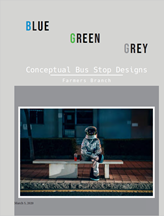
Green Bus Stop Design Guide - City of Farmers Branch
This guide was developed by the City of Farmers Branch to develop a process and tools for implementing green bus stops as part of standard development processes. This guide highlights the City’s overall purpose and approach to a green infrastructure project, and includes general information on project site selection, bus stop design templates, and a planning/design checklist that can be used by other agencies and municipalities for developing green bus stops.
Southlake BioPod Burney Lane Reconstruction
The City of Southlake purchased and installed a prefabricated BioPod biofiltration system as a test pilot project. The system includes water testing and monitoring to ensure its success. The City has created an internal dashboard to reflect all trends recorded since the project began.
University Park Micro-Detention Project 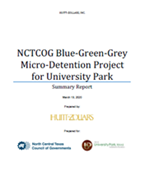
This project consisted of the design of a new micro-detention system for driveways. The project included a CAD design that will be used by the City of University Park in a future pilot at one of their facilities.
Green Transportation Infrastructure Virtual Workshop
The Green Transportation Infrastructure Virtual Workshop was held on August 24, 2021 from 9:30 AM to 2:30 PM through Zoom. The workshop provided a general introduction of green infrastructure practices as they relate to transportation and examples of their implementation in the Dallas-Fort Worth region. Specific project topics included permeable pavements, LED lighting, solar lighting, and low-impact stormwater drainage techniques.
Workshop Presentations
Morning Session [PDF]
Afternoon Session [PDF]
Workshop Recording
Workshop Agenda




Green Infrastructure Resource Guide
NCTCOG completed a guidebook in 2017 to aid professionals in assessing choices for integrating green infrastructure practices into various transportation projects such as roadways, sidewalks, parking facilities, and trail projects. The guidebook provides costs and benefits of these green practices, local case studies, and key information related to long-term cost effectiveness, community improvement, and environmental impacts. The following topics are covered in the Guidebook:
- Energy-efficient LED and solar lighting
- Green stormwater infrastructure elements such as permeable pavement and bio-retention
- Green trail materials and “cool” pavements
- Urban forestry and native plants
- Local examples
- Cost estimates
Green Infrastructure Resource Guidebook (May 2017)
Green Infrastructure Brochure
Local Examples
NCTCOG has funded a number of infrastructure projects through the Sustainable Development Funding Program that utilize green infrastructure components or strategies.
Below are some examples:
The Green at College Park – Arlington College Town, Arlington, Texas
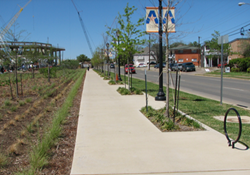 Location: Public open space adjacent to the University of Texas at Arlington Lipscomb Hall, fronting Third Street, Center Street, and Mitchell Street.
Location: Public open space adjacent to the University of Texas at Arlington Lipscomb Hall, fronting Third Street, Center Street, and Mitchell Street.
Accolades: SITES
Green Infrastructure Elements: Pedestrian walkway paved with pervious recycled glass material; bioretention drainage garden; and shade and paving materials with a Solar Reflection Index (SRI)
value of 29 or greater to reduce the heat island effect.
Thomasson Square, Mesquite, Texas
Location: Gus Thomasson Road between Moon and Karla.
Green Infrastructure Elements: Bio-swales with native vegetation in the median of the roadway to help drainage and filter runoff; bio-retention area between roadway and sidewalks for additional drainage and pedestrian safety; and shade trees to reduce the heat island effect.
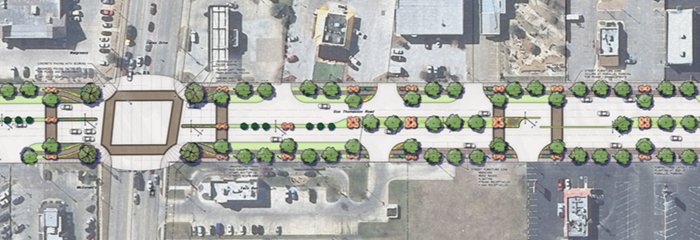
Additional Green Infrastructure Topics
Resources
- NCTCOG Sustainable Public Rights of Way
- NCTCOG Center of Development Excellence - Technical Tools: Library of sustainable planning documents and best practices
- NCTCOG Environment & Development Case Studies interactive map: Best practice case studies from around the North Central Texas region related to development excellence, solar energy, water, and waste
- EPA Green Infrastructure
- EPA Heat Islands

